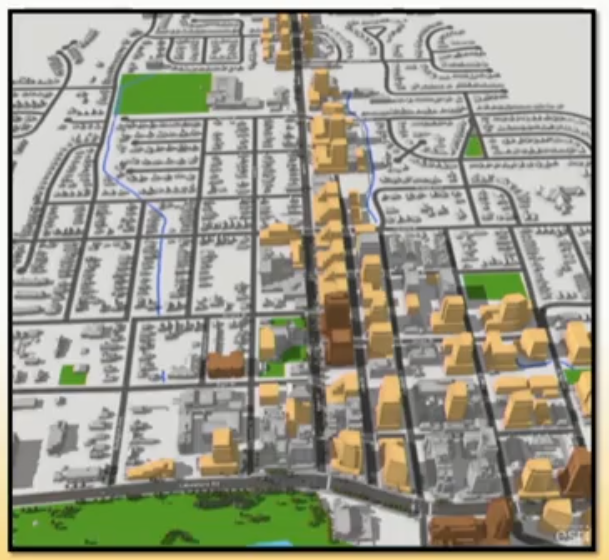 By Pepper Parr
By Pepper Parr
June 9th, 2022
BURLINGTON, ON
During a presentation on the capacity the fire department has to meet the challenges if there is ever a fire in a high rise.
The Gazette will report on that meeting in depth later in the day,
There was a graphic shown during the presentation that will give you a sense of what kind of growth Burlington is going to experience.
It isn’t exactly a pretty picture.

This is what the fire department thinks they are going to have to deal with in the future.




















It appears that the Nimby’s will do and say anything to prevent highrise buildings from being erected.
Are those living in the country where you can’t even find their homes in the dark any safer. Good luck getting an ambulance there in 4 minutes. Shall we sue the builders for not having water lines for the firetrucks in the country. Utter and complete nonsense.
The one thing that comes to mind, is that you are making a compelling case for the construction of more ground oriented development in the low density areas. Knock down a single family home in a stable neighborhood and replace it with a four storey 4 plex. No problem with the ladders reaching the occupants. Safe as can be.
There you go, if saving lives is what your are really interested in?? Why is this much safer form of housing void of your support?
Can the local developers count on you by using your fire concerns as legitimate reasons for invading the low rise stable neighborhoods?
Stephen.
Using your sue anybody for anything approach. Could we then sue council and the local Nimby’s for influencing the lack of safe, fireproof, ground oriented housing. Based on your silly arguments, by putting peoples lives in danger.
Completely agree that we do not take fire safety in high rises seriously. The appalling situation in London UK – Grenfell Tower fire, 2017 – should have alerted the world to the importance of the subject, yet there has hardly been a whisper about it here. We are very complacent.
Fire safety in high rise buildings is a Provincial responsibility; not a municipal one. So lobby your MPP. Oh good luck with that. Natalie Pierre will, I bet, be just as accessible as was McKenna.
The Grenfell fire was caused by an insulation applied post construction to the building and very much alerted the world to an unforeseen issue.
Ontario has a different building code which is frequently updated. Please enlighten us as to the last high rise fire in Ontario that had loss of life due to bad building regulations or the fire department couldn’t reach.
What always strikes me as hypocritical is the same people crying about building up are the same ones against building north of Dundas, or don’t build the 413 because heaven forbid someone will then build housing there.
As someone who has worked in Occupational Health & Safety, and who also teaches it, I can confirm that this is a significant and overlooked issue.
Repeated studies have shown that if you can’t get medical attention to someone within four minutes who has suffered a heart attack, stroke, etc., then the probabilities of long-term impairment or death increase substantially. Someone who is on the twentieth storey of a high rise has a noticeably reduced odds of survival or impairment than someone on the fourth floor, for example. The same is true for fire response. If your fire ladders only extend to the twelfth floor, and you’re on the twentieth, then good luck. And who, typically, lives in high rise developments on the upper floors? Older residents!
There is an important distinction between an office building and a high rise development insofar as health and safety administration is concerned. Under the Occupational Health & Safety Act of Ontario (or the Canada Labour Code, Part II for federally regulated employers), there is a requirement to have an OHS Representative in place for small workplaces with less than 20 employees, and an OHS Committee for larger offices. The Rep or Committee looks after things like training first aid attendants, administering the OHS program, emergency evacuations, workplace inspections, etc. In a high rise, the same structure isn’t in effect. Typically, the responsibility for health and safety is entrusted to the superintendent or the property management. Moreover, while common areas are inspected, residents’ units typically are not.
The problem with large aggregations of high rise developments in a congested space is that when there is a fire or evacuation where do the tenants go? Where do they stage while the fire is being fought? Also, the higher the fire the farther back the aerial ladder trucks need to go. When they had the fire at the Toronto Badminton Club at Yonge & St. Clair a few years ago this was the issue they faced. The fire trucks couldn’t get near the building because of traffic and lack of space. That’s why they had to fight the fire from the rooftops of neighbouring buildings because there was no easy access.
More should be done to ensure that real estate developers, planners and City officials take health and safety and emergency evacuation into consideration when approving planning applications. The other interesting issue is this: if a condo owner buys a property, and there is an emergency or fire, and that owner is then negatively impacted (i.e. medical complications, fire damage to their unit, etc.), can they then sue the developer, the City, etc., under the OHS Act or even the Ontario Municipal Act, for failing to provide proper safety and emergency response? An enterprising lawyer specializing in class action lawsuits might find this a unique and precedent- setting case.
Presently, I have been led to believe that the ladders that firemen use can only go up to the 10th or 11th floor.
Think this needs to be addressed, with all the high-rises built and being built.
Fire suppression systems are part of the building code already and factored into the building. The norm for a fire truck ladder is from 70-100’. Counting angles and distance from the building etc would make the average fire truck ladder reach the 6th floor.
I wonder if you have noticed there are a few super high rise buildings in Toronto and Mississauga that have floors considerably out of reach of fire truck ladders? This issue is addressed as best it can be by way of fire suppression systems, fire breaks etc. I wonder do you have reason to believe that the City of Burlington and the developers are unaware of the Provincial fire safety requirements? Or maybe you think the City has the ability to do something unilaterally?
How would you suggest the issue you raise be addressed?
One good thing about the OLT from the developer’s viewpoint is that it is not permitted to worry about the impact on such things as fire, power outages, schools, roads, traffic, open space, etc. And they listen only to “planner” and lawyers who are not interested in such trivia either.